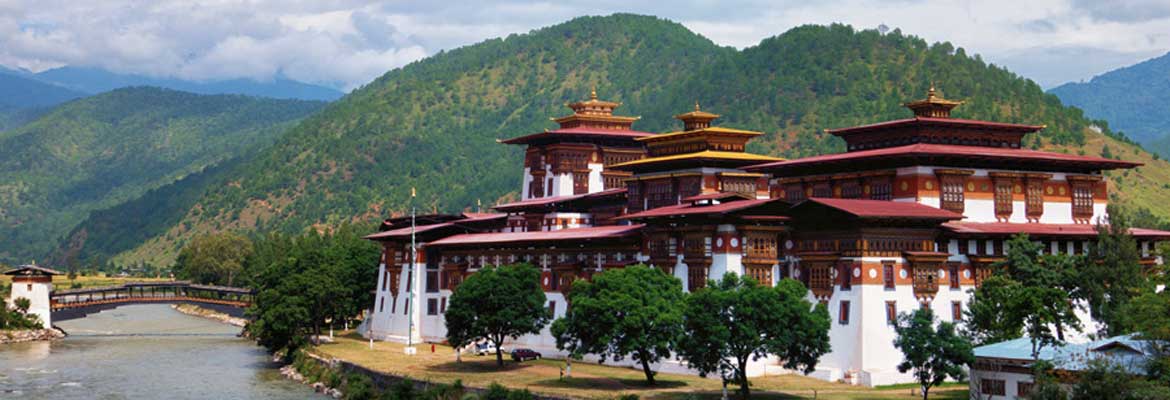
Punakha Dzong
Overview
Punakha Dzong, also known as Punthang Dechen Phodrang Dzong is one of the most beautiful Dzongs in Bhutan. It is idly located on a small plateu between the two biggest river of Bhutan – Pho Chu and Mochu. Punakha Dzong was constructed by the Zhabdrung Ngewang Namgyel 1637.The Dzong is second largest and oldest Dzong in Bhutan. According to a local legend, the sage Padmasambhava prophesized that “a person named Namgyal will arrive at a hill that looks like an elephant”. Ngawang Namgyal, 1st Zhabdrung Rinpoche, found the peak of the hill, which appeared in the shape of trunk of an elephant as prophesized, and built the Dzong in 1637-38. Another legend tells how Zowe Palep, the architect, had a vision in a dream after the Zhabdrung ordered him to sleep under a small structure which contained a statue of the Buddha, known as Dzong Chug “small Dzong”. In his dream, prompted by the psychic powers of the Zhabdrung, he had a clear vision of a palace for Guru Rinpoche. The vision was imprinted on the architect’s mind, enabling him to conceive the plan for the Dzong without putting the vision on paper and to build it. On the basis of the dream vision of the architect, the building of the dzong was started in 1637 and completed in 1638, at the place where the Dzong Chug had existed. During this period, Ngawang Namgyal became the first leader of a unified Bhutan, following his concerted efforts to unify the country into one unit. The Dzong was consecrated in the name of Pungthang Dechen Phodrang. In 1639, a commemorative chapel was erected to house the arms seized from the Tibetans who were defeated by the Bhutanese on this spot. The Zhabdrung also set up a monastic order with 600 monks (brought from Cheri Goempa of upper Thimphu valley) and he lived here till his death. The spire at the top of the Utse (the dzong’s central tower or the main tower was added in 1676 by Gyaltsen Tenzin Rabgye–the abbot of the Dzong. Further additions were made during the period 1744 to 1763, when Sherub Wangchuk was the ruler. The House of Wangchuck currently rules the country. This monarchy was established in 1907. The same year, Punakha Dzong was the site of the coronation of Ugyen Wangchuck (or Deb Nagpo) as the first Druk Gyalpo. At that time, Punakha was the capital of Bhutan. Three years from 1744 to 1763, the Dzong was enlarged substantially during the rule of the 13th Desi,
when Sherub Wangchuk was the chief abbot of Bhutan. Several fires between 1750 and 1849 caused damages to the Dzong. In the 1897 earthquake, the Dzong was severely damaged and also suffered numerous fires. In 1986, the Dzong was partially destroyed by fire. It is a six-storied structure with a central tower or utse at an average elevation of 1,200 metres (3,900 ft) with a scenic, mountainous background. The materials used in building the Dzong consisted of compacted earth, stones and timber in doors and windows. The dzong was constructed as an “embodiment of Buddhist values” and was one of the 16 dzongs built by the Zhabdrung during his rule from 1594 to 1691. The dzong measures 180 metres (590 ft) in length with a width of 72 metres (236 ft) and has three docheys (courtyards). The defensive fortifications built in the dzong to protect it from enemy attacks consist of a steep wooden draw stairway and a heavy wooden door that is closed at night. After the dzong suffered damage due to a fire, a large prayer hall was added in 1986.
Administrative offices of the dzong, a very large, white-washed stupa and a Bodhi tree are located in the first courtyard. Also seen in the same courtyard, on the far left, are a mound of stones and a chapel dedicated to the queen of the nagas. The residential quarters of monks are located in the second courtyard, with the utse intervening in between the first and the second courtyards. There are two historic halls in this courtyard; one of Ugyen Wangchuk, who subsequently became the King and another hall where the King was decorated in 1905 with the Order of the Knight Commander of the Indian Empire by John Claude White. The third courtyard is at the southernmost end of the Dzong where the remains of Pema Lingpa and Ngawang Namgyal are preserved. Machey Lakhang (‘Machey’ literally means “sacred embalmed body. In the third courtyard has the well preserved embalmed body of Zhabdrung. This Lakhang was rebuilt in 1995. The casket containing the embalmed body is not opened at all. However, the place is visited by the King and the Je Khenpo mainly to seek blessings before assuming their offices.
